Journal of Aeronautics & Aerospace Engineering
Open Access
ISSN: 2168-9792
ISSN: 2168-9792
Mini Review - (2021)Volume 10, Issue 12
Automatic Dependent Surveillance-Broadcast (ADS-B) system is one of the innovative technologies of surveillance system which is used for direct information exchange between aircraft- to-aircraft and Aircraft-to-ground station. The ADS-B receiver is used to receive a signal of 1090 MHz frequency from the antenna and convert it through the device RTL-SDR dongle whose function to capture the signal and monitor the given information like altitude, position, velocity, and aircraft identification, etc. This information during the flight is usually displayed to enhance the situational awareness of the pilot and its safety. Now ADS-B system is mandatory for all aviation systems operating around the globe because ADS-B is advance, efficient, faster, and smaller in size than the traditional radar system. This paper is structured as follows: firstly, there is an overview of the ADS-B system in the world. In the Second chapter discussed the literature review of the ADS-B system in detail. After, it comes to the study of the captured signal by RTL-SDR. The study of aerial traffic has followed the study of the signal, Methodology, at the final part, the conclusion is reported.
Innovative technologies; Altitude; Aircraft identification
Automatic Dependent Surveillance-Broadcast (ADS-B), the centerpiece of next-generation air transport networks, has been rapidly transforming the way the outmoded Secondary Surveillance Radar (SSR) and has been depicted in requiring aircraft to broadcast their geographic coordinates gained from modern satellite- based navigation systems. Due to the increased traffic in the aviation sector, the earlier radar system for surveillance is no longer sufficient to meet the demand for air traffic control for both military and civil aviation for a significant number of planes. The new surveillance mechanism has been developed to increase capabilities, and the quality of service has greatly improved.
ADS-B is a cutting-edge and reliable technology that replacing existing radar systems in aviation industry. The ADS-B Out component and ADS-B in component are 2 major components of based automated dependent surveillance-broadcast system. Its GPS Aerial surveillance way of transmit ting information via air-to-air and air-to-round data links.
When used in conjunction with other technologies to boosts ATC capacity and accounts for the airport's radar system flaws. Fairly low architecture, cost- effectiveness, and enhanced spatial awareness all are major benefits of ADS-B over traditional radar as well as radio systems, including both ATMs who do have access to more accurate statistics about the location, status, and pathways of all airplanes inside range and for ADS-B aerial vehicle who obtain data about some of the other airplane in the proximity airfields.
ADS-B system can help pilots with traffic monitoring as well as air traffic control. ADS-B will surely give greater accuracy data and a faster data update rate than a radar surveillance system. The CDTI (Cockpit Display of Traffic Information) allows the pilot to view the position of the neighboring aircraft as well as additional data, including its flight intention, speed, heading angle, and weather information, enabling the pilots to keep a safe path length. This indicates that, if the pilot is aware of the environment around, this sort of technology allows for unfettered flight and reduces ATC effort. Air Traffic Management (ATM) and Federal Aviation Authority (FAA) mandatory the use of Automatic Dependent Surveillance - Broadcast (ADS-B) till 2020.
Related work
"Avoiding collisions at any low cost: ADS-B-like position broadcast for UAVs." In this paper the use of a Wi-Fi beacon in an ADS-B system in order to increase the accuracy, efficiency, and GPS system of the system. To avoid collisions and get updates in real-time by using several protocols and methodologies [1].
"A Portable ADS-B Receiver for Air Traffic Surveillance." The purpose of this article is to develop an ADS-B portable receiver device that can receive, extract, decode ADS-B messages and show the studied aircraft trajectory in real-time on the software's simulated radar screen. It collects ADS-B signals from civil aviation aircraft, allowing for real-time tracking and monitoring of aircraft flight circumstances in the airspace, such as position, altitude, and so on, in order to avoid collisions [2].
"Security issues in Automatic Dependent Surveillance-Broadcast (ADS-B): A survey." This article examines ADS-B system vulnerability, lists several probable ADS-B attacks, and categorizes them based on attack purpose and security needs. In addition, we examine the most recent ADS-B security solutions and compare them in terms of security and feasibility [3](Table 1).
“Security of ADS-B: Attack Scenarios”. Despite several problems in ADS-B deployment strategy, as well as security issues caused by the technology's lack of authentication and encryption, ADS-global B's adoption continues to grow. As a result, air traffic controllers and airlines throughout the world will employ this technology extensively [4].
"SOS: Standard-compliant and packet loss tolerant security framework for ADS-B communications."We presented SOS a standard-compliant and loss-tolerant security framework for ADS-B communications, in this journal article. By use of symmetric encryption protocols, SOS ensures the authenticity and integrity of messages. It also makes use of the distributed system design that is common in open participation communities like Open Sky Network, which is built on a large number of spontaneous receivers sending detected ADS-B packets to centralized community servers. SOS is also robust to packet loss in this way [5](Figure1-5) (Table 2-6).
Block diagram
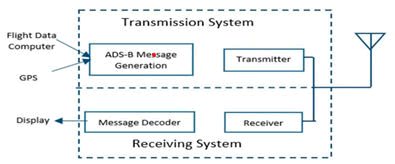
Figure 1: System working diagram.
Table 1: Ads-b ground position.
| Ground Position Information | ||
|---|---|---|
| 1-5 | TC | Type code |
| 6-12 | MS | Move status |
| 13 | F-hdg | Heading/track angle flag |
| 14-20 | Hdg | Heading/track angle |
| 21 | T | Time |
| 22 | F | CPR odd/even frame flag |
| 23-39 | LAT-CPR | Latitude in CPR format |
| 40-56 | LON-CPR | Longitude in CPR format |
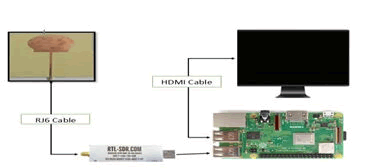
Figure 2: Hardware block diagram.
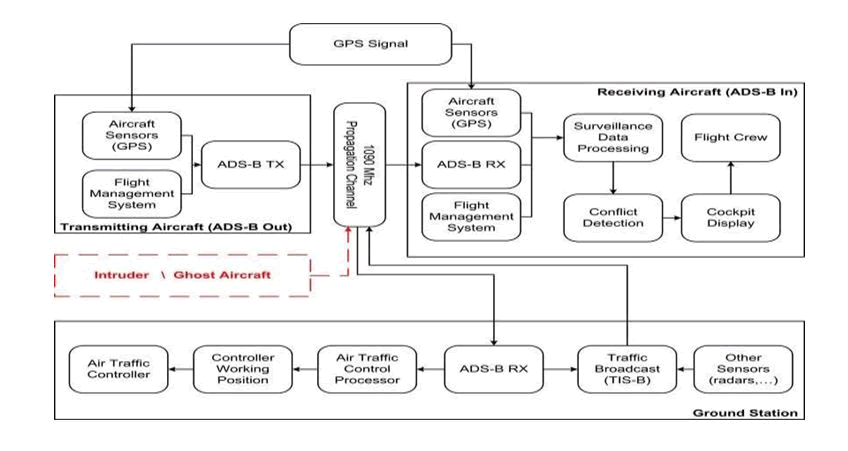
Figure 3: Sma connector specification.
Table 2: Electrical parameters.
| Electrical | |
|---|---|
| Impedance | 50 ohms |
| Frequency range | Dc- 18 GHz to 34 GHz |
| Voltage range | 335 volt FMS configuration |
| Di-Electrical withstand voltage | 1000 VRMS MIN |
| Copper jacket cable | 105.005 f(GHz) |
| Installation resistance | 5000 MΩ |
| Center contact resistance | 30Ω |
| Outer contact resistance | 20 mΩ |
| RF leakage | -60 DB Max(DC-3 GHz) |
| Inserting loss | 0.06 vf(GHz) Max |
| Power handling | 70 W @10 GHz@25 c |
Table 3: Mechanical parameter.
| Mechanical | |
|---|---|
| Mating Cycles | 500 min |
| Coupling Mechanism | Threaded |
| Interface Specification | MIL-S TD-348 |
| Mating Torques(Stainless Steel Plug) | 0.8-11 N-m (7-10 in lbs.) |
| Mating Torques(Brass Plug) | 0.3-0.6 N-m (3-5 in lbs.) |
Environmental Parameters
Table 4: Parameter of sdr-rtl dongle.
| Tuner | Frequency Range |
|---|---|
| Elonics E 4000 | 52-2200 MHz with a gap from 1100-1250 MHz |
| Rafael Micro R 820 T/2 | 24-1766 MHz |
| Fiti-power FC 0013 | 22-948.6 MHz |
| FCI | 146-308 MHz and 438-934 MHz |
Table 5: Antenna simulation and results.
| Environmental | |
|---|---|
| Typical | -65 c to +164 c |
| Styrene insulator or phosphor bronze contact | -40 c to +165 c |
| Thermal shock | MIL-STD -202 method 213(test condition B) except high temperature @200 c |
| Corrosion | MIL-STD -202 method 213(test condition B) -5% salt solution |
| Vibrations | MIL-STD -202 method 213(test condition D) |
| Mechanical shacks | MIL-STD -202 method 213(test condition I)- no discontinuity |
| Moisture resistance | MIL-STD -202 method 106 |
| Attitude | MIL-STD -202 method 105(test solution c) |
Table 6: Antenna simulation value.
| Freq | Sim S 11 | Freq | Meas S 11 |
|---|---|---|---|
| 0.7 | - 9.70199 | 0.705 | -9.0199 |
| 0.8 | - 16.9535 | 0.805 | -15.6907 |
| 0.825 | - 19.0498 | 0.83 | -20.1379 |
| 0.85 | - 20.6927 | 0.855 | -21.1439 |
| 0.95 | - 17.6993 | 0.955 | -18.4862 |
| 0.975 | - 16.5463 | 0.98 | -17.2123 |
| 0.985 | - 16.1464 | 0.99 | -16.7595 |
| 0.99 | - 15.9595 | 0.995 | -16.5463 |
| 1 | - 15.6114 | 1.005 | -16.1464 |
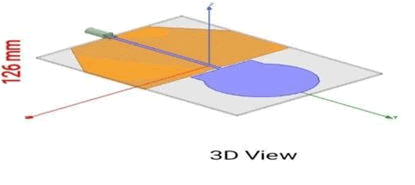
Figure 4:: 3D view.
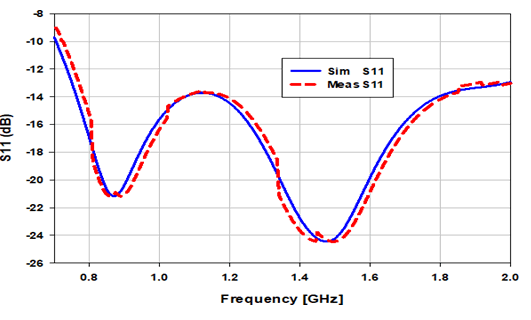
Figure 5: Frequency.
The purpose of this study is to develop a real time Automated Dependent Surveillance Broadcast Receiver (ADS-B) which will receive signal through an antenna when aircraft, with an ADS-B transponder which continuously transmits it squawk code and further aviation information for proper navigation from Air Traffic Control, come in range of antenna. Once the signal is detected of frequency of 1090 MHz, as set by the International Civil Aviation Organization (ICAO) AND Federal Aviation Authority (FAA), once the signal is received it will be sent to the RTLSDR dongle which is an open-source system used to tune the signal and remove all the noise and disturbance from it. The signal is then sent to the decoder which here is the Raspberry PI which will decode all the signal and will translate it into bits once the decoding is done the data will be transferred to the display screen which with the application of Air Spy will show the map of the area which is in the range of an antenna, and all the information regarding the aircraft like its:
Flight identification (flight number call sign or call sign)
The aim is to design this system is to make a set towards the commercialization of ADS-B, since Civil Aviation Pakistan itself is taking the services of ADS-B from the other countries and our surveillance is in their hands. By working on the updating of ADS-B and its commercialization Pakistan will be able to perform its surveillance without the interruption of any other organization [6].
Citation: Abbasi ZA, Chana S, Ali A, Ali I, Shahabuddin (2022) Automatic Dependent Surveillance-Broadcast (Ads-B) Receiver Using Raspberry Pi. J Aeronaut Aerospace Eng. 11:284
Received: 18-Feb-2022, Manuscript No. jaae-21-15228; Editor assigned: 21-Feb-2022, Pre QC No. jaae-21-15228; Reviewed: 07-Mar-2022, QC No. jaae-21-15228; Revised: 11-Mar-2022, Manuscript No. jaae-21-15228; Published: 18-Mar-2022 , DOI: DOI: 10.35248/2168-9792.22.11.284
Copyright: © 2022 Abbasi ZA, et al. This is an open-access article distributed under the terms of the Creative Commons Attribution License, which permits unrestricted use, distribution, and reproduction in any medium, provided the original author and source are credited.